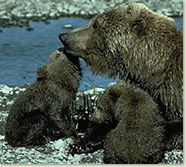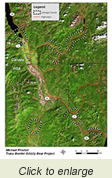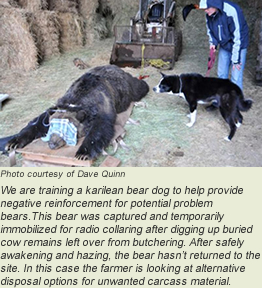
resources

Linkage Zones
Our GPS radio collar work has identified several linkage zones where bears prefer to move through human environments to access their backcountry foraging areas. These are areas where management efforts to reduce bear attractants are required to reduce mortality risk for bears that might move through these linkage zones. For more detailed information see our linkage report.
Click to link to maps for:
Duck Lake Linkage Zones
Hwy 3 Linkage Zones
Bear Aware
British Columbia has a Bear Aware program that provides communities with an education specialist to encourage the general public, landowners, and homeowners, to learn ways to coexist with bears, by reducing their bear attractants around their home or farm. To link to the BC Bear Aware program click here: www.bearaware.bc.ca
BC also has a Bear Smart program where a community can get assistance in attaining Bear Smart status To connect to the BC Bear Smart program click here: www.env.gov.bc.ca/wld/bearsmart/bearsmintro.html

Report a Problem Grizzly
The Trans-border Grizzly Bear Project has been working with the regional Conservation Officers in the South Selkirk and Purcell Mountain areas to haze potential problem bears away from settlements. It is important that we intervene in these events before a bear has received too much of a food reward. Bears that have learned to get easy human-based food over a period of time are too difficult to rehabilitate. But if we get to the bear early enough, it works pretty well. So, it is important that we have a relatively quick response to a potential bear problem.
We encourage residents to call the Conservation Office wildlife conflict hot Line 1-877-952-7277 if they have a grizzly bear in their yard or farm. Learn more >>
Bear-proof your Home Site
Here are some links to websites with good information on how to bear-proof you home site or farm.

Bear-proof Garbage Can Loan Program
Residents living in the areas between Castlegar, Nelson, Creston, and Cranbrook BC are encouraged to try out bear-resistant garbage containers on a trial basis. They can be borrowed for free for up to 2 months and then, if interested, purchased for $240. For more information or to check out a container, please call our Joanne Siderius at 250-359-7036 or Michael Proctor at 250-353-8072.
Electric fencing
Electric fencing has been shown to be an effective tool for keeping wildlife and predators away from potential human food sources. It does require careful construction. If desired, we can provide help in designing and setting up fences, (Call Michael Proctor 250-353-8072). Here are a few links to websites providing information on electric fencing.
www.bearsmart.com/becoming-beasr-smart/community/electric-fencing
www.bearaware.bc.ca/electric-fencing.htm
www.wildlife.alaska.gov/index.cfm?adfg=bears.efences
Practical Electric Fencing Resource Guide: Controlling Predators (2009)
Education slide shows
Being built, please check back soon.
Know your Bear Species
Several grizzly bears are killed each year in the region because they are mistakenly thought to be black bears. To help reduce the chances of mistakenly killing a threatened grizzly bear, learn how to tell the difference between the species. Your identification can help make a difference, particularly when calling a Conservation Officer, who will apply different management to each species. Sometimes it can be challenging to tell the species apart, especially with a partial view or in twilight conditions. Color is often a poor indication of bear species. The best indicate is the presence of very long claws on the front paws. These can be seen directly or in foot prints. Remember, the hind paws of both species have short claws. For other indicators of species, check out the following websites:
The Get Bear Smart Society: Know the Difference
Western Wildlife Outreach: Grizzly Bear Identification
YouTube Video by WhyteMuseum: Physical differences between black bears and grizzly bears
Back to Top
|





